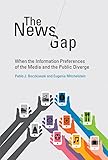The news gap : when the information preferences of the media and the public diverge /
By: Boczkowski, Pablo J
Title By: Mitchelstein, Eugenia
Material type: BookPublisher: Cambridge, Mass. : The MIT Press, c2013.Description: xii, 302 p. : ill. ; 24 cm.ISBN: 9780262019835 (hardcover : alk. paper)Subject(s): Online journalism | Online journalism -- Social aspects | Online journalism -- Political aspects | News audiencesDDC classification: 070.4 Online resources: Location Map
BookPublisher: Cambridge, Mass. : The MIT Press, c2013.Description: xii, 302 p. : ill. ; 24 cm.ISBN: 9780262019835 (hardcover : alk. paper)Subject(s): Online journalism | Online journalism -- Social aspects | Online journalism -- Political aspects | News audiencesDDC classification: 070.4 Online resources: Location Map | Item type | Home library | Call number | Status | Date due | Barcode | Item holds |
|---|---|---|---|---|---|---|
| REGULAR | University of Wollongong in Dubai Main Collection | 070.4 BO NE (Browse shelf) | Available | T0025913 |
, Shelving location: Main Collection Close shelf browser

|

|

|

|

|

|

|
||
| 070.4 AT AL Alternative journalism / | 070.4 AY WA War reporting for cowards / | 070.4 BE FU The future foreign correspondent | 070.4 BO NE The news gap : | 070.4 BR JO JournalismNext : | 070.4 BR JO Journalism next : | 070.4 BR ON The online journalism handbook : |
Includes bibliographical references (p. 255-300) and index.
When supply and demand do not meet -- How the content preferences of journalists and consumers diverge: the gap in the United States, Western Europe, and Latin America -- The difference that politics makes: the gap during a presidential election and a national government crisis -- New wine in old bottles: how storytelling matters in the gap between the supply and demand of online news -- Reading what's interesting, sharing what's bizarre or useful, and discussing what's controversial: gaps in various forms of interaction with online news -- The meaning of the gap for media and democracy.
The sites of major media organizations -- CNN, USA Today , the Guardian , and others -- provide the public with much of the online news theyconsume. But although a large proportion of the top stories these sites disseminate cover politics,international relations, and economics, users of these sites show a preference (as evidenced by themost viewed stories) for news about sports, crime, entertainment, and weather. In this book, PabloBoczkowski and Eugenia Mitchelstein examine this gap and consider the implications for the mediaindustry and democratic life in the digital age. Drawing on analyses of more than50,000 stories posted on twenty news sites in seven countries in North and South America and WesternEurope, Boczkowski and Mitchelstein find that the gap in news preferences exists regardless ofideological orientation or national media culture. They show that it narrows in times of heightenedpolitical activity (including presidential elections or government crises) as readers feel compelledto inform themselves about public affairs but remains wide during times of normal politicalactivity. Boczkowski and Mitchelstein also find that the gap is not affected by innovations inWeb-native forms of storytelling such as blogs and user-generated content on mainstream news sites.Keeping the account of the news gap up to date, in the book's coda they extend the analysis throughthe 2012 U.S. presidential election. Drawing upon these findings, the authors explore the news gap'stroubling consequences for the matrix that connects communication, technology, and politics in thedigital age.
